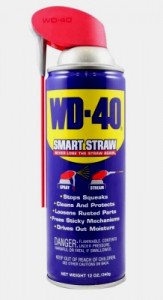A fairly common question we get asked by our customers is “What type of lubricant should I use on my practice lock?”
Most locksmiths will tell you to use powdered graphite lubricant in any lock. Powered graphite is made up of very tiny sheets of carbon molecules that slide easily across each other. The advantage of graphite is that it is not sticky like greases and oils and therefore will not attract dust. Oily dust will gum up small parts like lock pins.
The problem with using powdered graphite is that graphite is a black powder that gets on everything and is very hard to clean up. We don’t suggest using powdered graphite in a lock that you are going to frequently disassemble because handling graphite covered parts is going to make a mess.
 The next option is to use a lubricating oil. WD-40 is a probably the most familiar home shop lubricant and will do a good job of lubricating locks without the permanent black stains in the sofa. The problem with oil is that it’s just so darn oily. After changing pin configurations a few times, you’ll end up with oil stains on the sofa instead.
The next option is to use a lubricating oil. WD-40 is a probably the most familiar home shop lubricant and will do a good job of lubricating locks without the permanent black stains in the sofa. The problem with oil is that it’s just so darn oily. After changing pin configurations a few times, you’ll end up with oil stains on the sofa instead.
Our recommendation is to use no lubricant at all. The brass housing, brass plug, and brass pins will glide across each other with very little friction and will work for a long time with no perceivable wear. Brass tends to be self lubricating when used with small forces and lock picking should involve very small forces. If dust, dirt, or a little brass dust from hours of picking seem to gum up the works, you can always use WD-40 to wash out your lock and follow up with rubbing alcohol to wash out the oily WD-40. Rubbing alcohol will evaporate quickly leaving a dry, clean lock


 We had an opportunity to visit the International Spy Museum in Washington D.C. last week. The museum was definitely worth the visit if you’re ever in the nation’s capital. It’s only a couple of blocks from Chinatown which makes it convenient for an interesting day of spy swag and lo mein.
We had an opportunity to visit the International Spy Museum in Washington D.C. last week. The museum was definitely worth the visit if you’re ever in the nation’s capital. It’s only a couple of blocks from Chinatown which makes it convenient for an interesting day of spy swag and lo mein. The Ultimate Practice Lock is made from Brass. Brass is a great choice for high quality lock cylinders because brass is self-burnishing. As brass keys slide across brass pins thousands and thousands of times, the brass surfaces polish each other instead of grinding away at each other. If locks, pins, and keys were made of iron or steel, repeated use would wear all parts. This happens less with brass.
The Ultimate Practice Lock is made from Brass. Brass is a great choice for high quality lock cylinders because brass is self-burnishing. As brass keys slide across brass pins thousands and thousands of times, the brass surfaces polish each other instead of grinding away at each other. If locks, pins, and keys were made of iron or steel, repeated use would wear all parts. This happens less with brass.